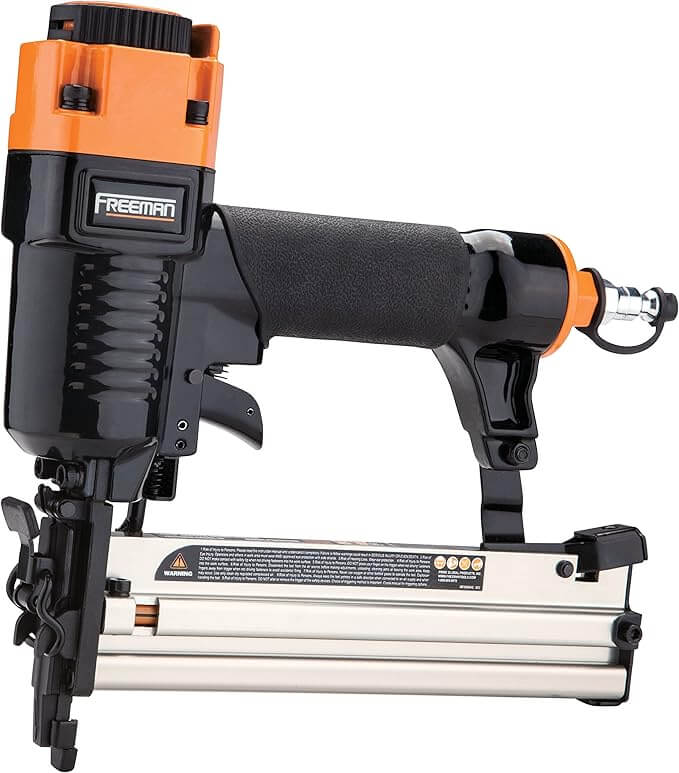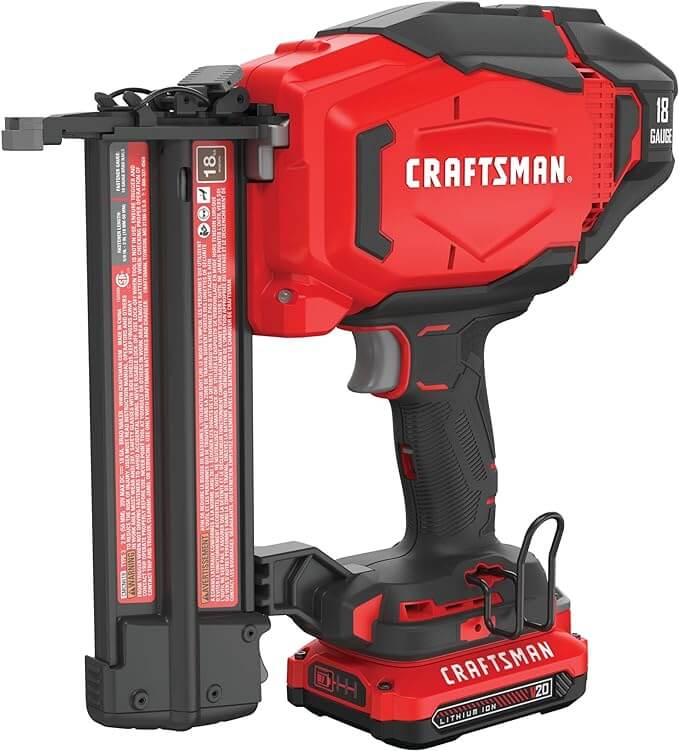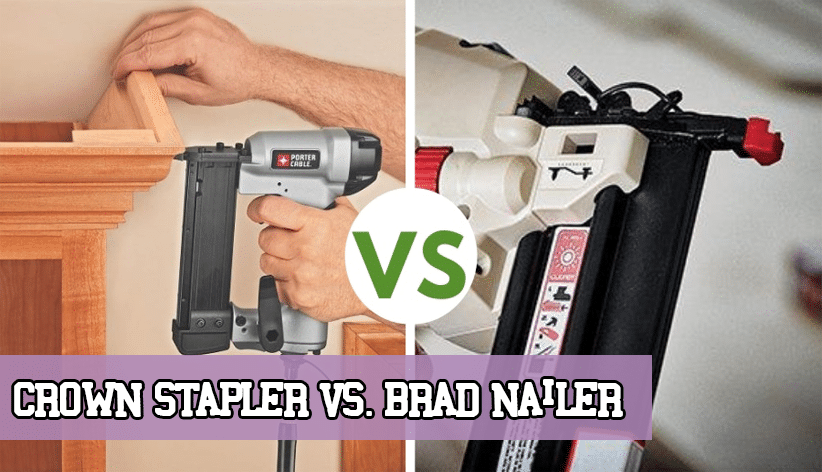The main difference between a brad nailer and a crown stapler is that brad nailers drive nails that are thin and leave tiny marks, making them great for trim and small wood projects.
Crown staples have two legs that hold tighter but leave bigger marks which is best for fabric and cabinet backs.
Crown staplers and brad nailers have unique benefits that make them ideal for different projects. Each tool has its advantages and disadvantages.
What is a Crown Stapler?
A crown stapler is a type of staple gun that is specifically designed to fasten fabric to wood. It is commonly used in upholstery projects where a tight stretch of the fabric is required.
Crown staplers are powered by either battery or compressed air, and they use a long strip of staples that are fed into the gun. The staples are then driven deep into the wood by a powerful motor, creating a tight and secure hold.
Crown staplers are great for upholstery projects because they can fasten the fabric very tightly to the wood. This ensures that the fabric will not sag or wrinkle over time.
However, one downside of using a crown stapler is that the staples can damage the wood if they are removed. Additionally, the holes left by the staples will be visible, even if they are filled and sanded.

Pros and Cons of a Crown Stapler
Pros
- Comes with three different widths: wide, medium, and narrow
- Used for a variety of projects
- Fastens fabric tightly to the wood
- Powered by either battery or compressed air
Cons
- The staples can damage the wood if they are removed
- The holes left by the staples will be visible, even if they are filled and sanded.
- A bit expensive, depending on the types
What is a Crown Stapler Used for?
Crown staplers are used in a wide range of industries, including furniture making, cabinetmaking, construction, and so on. The most frequent application of crown staples is upholstery work.
You may also make bent laminations with a crown staple by attaching it to wood.
A bent-lamination is a process where you glue together thin strips of wood and then bend or curve them for use in furniture like chairs. You can secure the strips better as the glue dries by using a crown stapler.

You can also use a crown stapler to keep the backs of picture frames together. The staple is deep enough to go through the miter joints from behind, holding everything in place without ruining the look.
The crown stapler can also be used to build or repair cabinets and drawers, as well as make and mend doors.
Crown staples can be used in many different ways, but they leave big holes because of the crown on the staple. So it’s ideal for projects that don’t require a smooth finish like upholstery work or bent laminations.
Here is a list of some of the most common uses for crown staples:
- Upholstery work
- Cabinetmaking
- Construction
- Picture framing
- Furniture making
- Door-making and repair
- Drawer-making and repair
- Installing thin trim and moldings, etc…
What is a Brad Nailer?
Brad nailers are one of the most widespread air-driven tools in a workshop. They’re intended to shoot light gauge wire brads into all sorts of wood without making a hole or damaging the wood.
This is very handy when you don’t want to mar the wood’s surface or leave a big gaping hole that needs filling later on.
A brad nailer can be used for both paperboard and wood, with the most typical application being to fasten baseboard and trim.
The wire brads that are shot out of a brad nailer are often made of aluminum or steel. These materials are both very strong, making them ideal for use in construction applications.
Brad nailers mostly shoot 18 gauge wire brads, but some models can shoot smaller or larger gauge wire brads.
Brad nailers use an air power mechanism to shoot out the brads. There is a small tank of compressed air that is connected to the gun. When you pull the trigger, the compressed air is released and drives the brad out of the gun.
When you need to be precise, a brad nailer is a perfect tool for you. They are smaller and easier to maneuver than other options, making them ideal for delicate projects that could easily split the wood if not handled correctly.

Pros and Cons of a Brad Nailer
Pros
- Easy to maneuver
- Nails can be easily removed
- Makes unnoticeable holes
- Precise
Cons
- Now powerful enough for thick and hardwoods
What is a Brad nailer used for?
Brad nailers are commonly used in construction, woodworking, and cabinetmaking. It’s mainly used for preparing wood joints and installing trim. It can also be used to install doors, window frames, and baseboards.
A brad nailer is an essential tool for anyone who wants to do woodworking or construction work. It’s perfect for delicate projects that require precise nails, like installing trim or baseboards.
It’s also a good choice for projects that require a lot of nails, like building a deck.

You have to remember that Brad nailers are not for heavy duty work such as nailing hardwoods. Brad nailers are mostly used to join materials together while preventing any damage to the materials.
Paneling would be an ideal project to use a Brad nailer on. The nails are small enough that they won’t split the wood, and they will create a tight bond between the paneling and the wall.
If you’re worried about the holes that the nails will leave behind, you can always fill them in later with putty or caulk.
Another great use for a brad nailer is attaching crown molding. The nails are small and precise, so you won’t have to worry about the molding splitting or the nails popping out.
Some people might also use a brad nailer to upholster furniture. The nails are small and won’t leave big holes in the fabric.
Brad nailers are not ideal for nailing hardwoods because the nails are not strong enough. If you’re working with hardwoods, you should use a nail gun that is designed for that type of material.
Here is a list of some of the most common uses for Brad nailers:
- Trimming
- Molding
- Baseboards
- Paneling
- Attaching thin pieces of wood
- Fastening light fixtures
- Installing small signs
- Making picture frames
- Temporary holding during construction projects, etc…
Crown Stapler vs Brad Nailer – Key Differences
Choosing between a crown stapler and a brad nailer depends on your project, the material, and the finish you want.
Fastener Size
Crown Stapler
- Staples come in narrow, medium, and wide sizes.
- Narrow crown (¼” wide): Best for trim and paneling.
- Medium crown (⅜” wide): Great for upholstery and furniture.
- Wide crown (½” or more): Strongest hold, used in construction.
Brad Nailer
- Common 18 gauge brads are 5/8″ to 2″ long that is perfect for finishing work.
- Brads leave small holes.
Type of Fasteners Used
Each tool works with different types of fasteners, affecting how well they hold things together.
Crown Stapler
- Uses staples with two prongs that dig into the material for a strong grip.
- Staples come in narrow, medium, and wide sizes.
- Wider staples hold better but leave bigger marks.
Brad Nailer
- Uses thin brad nails that blend into the surface.
- Brad nails have a small head which are nearly invisible.
- Commonly used 18 gauge brads are great for finishing work.
Holding Strength
Crown Stapler
- Stronger hold because of the two-pronged staple.
- Best for upholstery, cabinet backing, and soft materials.
Brad Nailer
- Holds well but not as strong as a stapler.
- Great for wood trim and delicate work where too much pressure could cause cracks.
- Not meant for heavy duty work.
Surface Impact
Crown Stapler
- Leaves visible staple marks.
- May need extra work to cover up the holes.
Brad Nailer
- Leaves tiny and nearly invisible holes.
- No extra work is needed to make it look good.
Suitable Materials
Crown Stapler
- Works best on softwood, thin plywood, and fabric.
- Good when you need strong holding power but don’t care about how it looks.
Brad Nailer
- Great for hardwood, MDF, and trim.
- Best when you want a smooth, professional looking finish.
Common Uses
Crown Stapler
- Upholstery and furniture.
- Backing for cabinets and light wood panels.
- Securing thin plywood.
- DIY home repairs need extra strength.
Brad Nailer
- Baseboards, crown molding, and trim.
- Attaching small wood pieces without cracking.
- Making furniture with a clean look.
- Cabinets and detailed woodwork.
Versatility
Crown Stapler
- More versatile for securing materials that need extra strength.
- Can be used for both wood and fabric.
Brad Nailer
- More precise for woodworking and finishing.
- Easy to use when you need accuracy.
Durability
Crown Stapler
- More durable for heavy work.
- Built to handle frequent use.
Brad Nailer
- Lasts long with care but is not as tough as a stapler.
- Needs regular cleaning to avoid jamming.
Cost
Crown Stapler
- More affordable.
- Staples cost less than brad nails.
Brad Nailer
- A bit more expensive due to precision.
- Brad nails cost more but give a cleaner finish.
Brad Nailer vs Crown Stapler – At a Glance
| Feature | Crown Stapler | Brad Nailer |
| Fastener Type and Size | Staples (Narrow: ¼”, Medium: ⅜”, Wide: ½”or above) | 18-gauge brad nails (⅝” – 2″) |
| Cost | More affordable and crwon staples are cheaper than nails. | Slightly more expensive but brad nails cost more. |
| Holding Strength | Stronger hold due to two pronged staples. | Moderate hold and good for delicate materials |
| Surface Impact | Leaves visible staple marks | Nearly invisible holes |
| Suitable Materials | Softwood, thin plywood, fabric | Hardwood, MDF, trim |
| Common Uses | Upholstery, cabinet backing, plywood, and general repairs | Baseboards, molding, cabinetry, and furniture |
| Versatility | Works with wood and fabric, more versatile | More precise for woodworking and finishing |
| Durability | Built for heavy work, long-lasting | Durable but requires regular maintenance |
Which one is better – Narrow Crown Stapler vs Brad Nailer
A crown stapler and a brad nailer are used for different projects. Before choosing your tool, experts suggest to justify yours project type.
Then analyze your type of material for the specific project. If you justify your project and material correctly, then it will be too easy to choose which fastening tool is best suitable for you or your workers.
A crown stapler is great for strong holds because it uses two pronged staples. It works best for upholstery, cabinet backing, and repairs.
However, staples leave visible marks, so it’s not ideal for projects where looks matter.


A brad nailer uses thin 18 gauge brad nails that leaves tiny and almost invisible holes. It’s perfect for baseboards, molding, furniture, and woodworking where a clean, professional finish is important. However, it doesn’t hold as strongly as a stapler.
As a result, If you need extra strength, go with a crown stapler. If you want a smooth and clean finish choose a brad nailer.
For fabric, backing panels, and light construction, a stapler is better. For trim, furniture, and detailed work, a brad nailer is the right choice.
FAQs on Crown Stapler vs Brad Nailer
Can a crown stapler use brad nails?
Ans: The thing about crown staplers is that they have a much higher power output than brad nailers. This means they can fire nails that are bigger and longer.
So, while you can technically use brad nails in a crown stapler, it’s not recommended because the nails are too small and could potentially get stuck in the tool.
Can I use a crown stapler for Trim?
Ans: Yes, you can use crown staplers for trim work. However, it’s worth noting that crown staplers are not as precise as brad nailers.
So, if you’re working on a project that requires precision, then you need to use a brad nailer instead.
Do staples hold better than nails?
Ans: Yes, staples are designed to hold better than nails. This is because they have a much wider surface area that holds the material in place.
However, it’s worth noting that both staples and nails can come loose over time. So, if you’re looking for a more permanent solution, then you might want to use screws or bolts instead.
Can you use a crown stapler for the carpet?
Ans: Narrow crown staplers have the best chance of working with carpets. The reason is that the staples need to be long enough to go through the thickness of the carpet and still have enough length to go into the wood underneath. If the staples are too short, then they won’t be able to grip the carpet properly.

